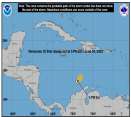CoconutCandy
User

Reged:
Posts: 245
Loc: Beautiful Honolulu Hawaii
|
|
(Mods: Please feel free to move this post and it's question to the 'Hurricane Ask/Tell' Forum.)
>> Can someone please tell me where I can see a visual of a ridge, and explain to me what to look for?
(Reply to 'Texas Cane Tracker' from Post 77721. Apologies to the Mets. Any Mets feel free to extrapolate.)
Well, that's just it. You can't really 'see' a ridge. Since a ridge is high pressure, with sinking air and fair weather (as opposed to a trough of low pressure, with its' rising air and easily-visible stormy weather), there really isn't much to see, as air is normally transparent.
But what you *can* see is the effects of the ridge on the surrounding stratocumulus cloud fields over huge areas of open ocean.
You see, a ridge is an elongated area of high pressure, often extending for hundreds or even thousands of miles, usually east/west, and is sometimes anchored to a high pressure cell at one or both ends, but not always.
And since air flows *outward* from high pressure (inward towards low pressure) winds below (south of) the ridge "axis" blow generally from the E or ENE or NE, and, on the north side of the ridge axis, they blow from the W or WSW or SW.
It is the ridge, which is a semi-permanent feature in the summer months, that provides us the trade winds over the open oceans. Life without the tradewinds (they occasionally die down for various reasons) can be miserable, as they truly are natures' air-conditioning.
So, if you view a large area of ocean on a satellite map (visible daytime loop is better) which is clear and free of storms, you can see huge areas where the cumulus clouds are flowing along from the E or NE. But north of that area, you may see the clouds blowing in the opposite direction, from the W or SW. The broad, elongated, sometimes cloud free area which separates the two, is the ridge axis itself, which is sinking, dry air thus doesn't really provide anything to 'see'.
But, just because you can't see it, (except indirectly, by it's 'reflection' on the motions of the cloud fields over huge areas of ocean) the ridge is incredibly important because, as mentioned, it provides the trade winds, *AND* it 'steers' storms and hurricanes located below the ridge axis west or west-northwest.
Whenever you see a storm or hurricane moving west or west-northwest, as Hurricane Felix is currently doing, it is the effect of the all-important ridge gently 'pushing' it along and preventing it from moving very much northward.
When the ridge 'runs out' in it's horizontal extent, breaks down, or is eroded away, there forms, instead, a 'weakness' which the storms/hurricanes will tend to move towards. That's when the storms will turn NW or N or even NE, because the ridge is no longer there and no longer 'pushing' them westward.
Here's a good article from Wikipedia that should help you understand and 'visualize' the Subtropical ridge.
http://en.wikipedia.org/wiki/Subtropical_ridge
There's even a nice picture of the East/Central Pacific and the Hawaiian Islands in the article, showing the importance of the subtropical ridge in providing Hawaii with our nearly constant breezy cooling tradewinds.
|
dem05
User
Reged:
Posts: 368
Loc: Port Charlotte, FL
|
|
Well, the eye of Hurricane Felix is now becomming very identifyable on the satellite this morning...as can be seen on the JSL and Rainbow Floater loops.
JSL: http://www.ssd.noaa.gov/goes/flt/t1/loop-jsl.html
Rainbow: http://www.ssd.noaa.gov/goes/flt/t1/loop-rb.html
The radar loops from the French Antillies, which Mike C and company have posted under the main post on this thread paint an excellent radar representation of Felix as well this morning.
I've been pulling for the ABC islands in hopes that they will not see Hurricane Forcewinds down there today. It is definately not another day in paradise down there, but from the looks of it, Aruba and the Dutch Antillies may stay just far enough south of Felix to escape sustained winds of hurricane force...although hurricane force wind gusts are a slight, realistic possibility in one or two squalls down there.
Down range, the has closed the gap on the rest of the model guidance, so the models may be approaching an agreement on a more specific path/direction of movement in the western Carribean. Unfortunately, this storm looks likeit is going to be another Hurricane for the history books. Otherwise, there is a low developing off the Georgia Coast this morning. Something to keep an eye on for potential slow development, as the more reliable models do carry some vorticity in the area off the SE US for the next few days. In the mean time, the models do not show this area of low pressure off of Georgia as a system that will have any significant affect on the ridging that is steering Felix on a w-wnw path.
Edited by dem05 (Sun Sep 02 2007 07:17 AM)
|
|




 Threaded
Threaded




